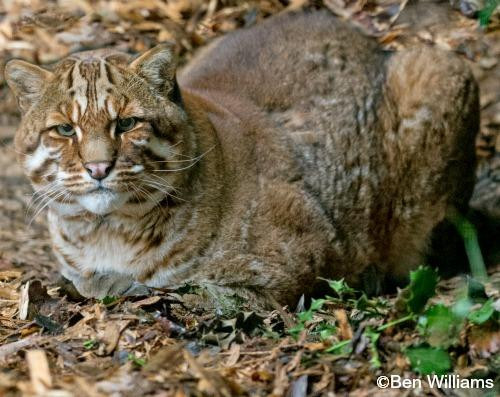The Asian Golden Cat (Catopuma temminckii) remains one of the most elusive and least understood wild cat species inhabiting the dense forests of Southeast Asia. This medium-sized felid is shrouded in mystery, partly due to its nocturnal habits and preference for dense, remote habitats. Adding to its enigmatic nature is the remarkable variation in its coat color, ranging from the typical golden hue to grey and even melanistic forms. This article delves into the fascinating world of the Asian golden cat, exploring its physical characteristics, distribution, ecology, reproduction, and the critical conservation challenges it faces.
 asiatic golden cat
asiatic golden cat
Physical Characteristics: A Coat of Many Colors
One of the most striking features of the Asian golden cat is its highly variable pelage. While the most frequently observed coat color is a rich golden or reddish-brown, these wildcats can also exhibit dark brown, grey, and even black (melanistic) coats. Intriguingly, a spotted morph, resembling an ocelot with its rosette patterns, also exists, adding further complexity to their appearance. Researchers are still investigating whether these diverse color morphs are linked to specific geographical locations or environmental factors.
Beyond coloration, the Asian golden cat possesses distinctive facial markings. Prominent white lines, bordered by dark brown to black, extend across their cheeks, from the nostrils towards the cheekbones, at the inner corners of their eyes, and upwards towards the crown. Their rounded ears are black on the back with a noticeable grey spot in the center. The underside of the cat, including the chest, abdomen, and inner legs, is typically white with light speckling. The legs and tail transition to grey to black towards their tips. Notably, the terminal half of the tail is white underneath, and they often carry their tail with the end curled upwards. Males are typically larger than females, a characteristic known as sexual dimorphism.
Key Physical Stats:
- Body Length: 66-105 cm (26-41 inches)
- Tail Length: 42-57 cm (16-22 inches)
- Height: Approximately 40 cm (16 inches)
- Weight: 8.5-15 kg (19-33 lbs)
Distribution and Habitat: From Foothills to High Altitudes
The Asian golden cat is a forest-dependent species, primarily inhabiting subtropical and tropical evergreen forests. However, they are adaptable and can also be found in more open habitats with rocky terrain, leading to their local name “rock cat” in parts of China. Their geographical range extends across a wide swathe of Asia, from Nepal and Northeast India, throughout Southeast Asia, including China, Thailand, Malaysia, and Sumatra. Interestingly, they are absent from the island of Borneo.
 asiatic golden cat range map
asiatic golden cat range map
Studies in Sumatra have revealed that Asian golden cats in that region are exclusively found in lowland forests, unlike Clouded Leopards (Neofelis nebulosa) and Marbled Cats (Pardofelis marmorata) which also inhabit montane forests. Similarly, hill forests in India are home to Clouded Leopards and Marbled Cats, but not Asian Golden Cats. However, camera trap evidence has shown the remarkable adaptability of this species to high altitudes, with both spotted and reddish coat morphs recorded at elevations of up to 3,730 meters in Bhutan’s dwarf shrub and grassland habitats. In 2009, Nepal documented the first-ever melanistic Asian golden cat in the wild through camera trapping, further highlighting the species’ diversity and range.
Home range studies in Thailand revealed that an adult female Asian golden cat had a home range of 32.6 km², which significantly overlapped (78%) with a male’s larger range of 47.7 km². Interestingly, Asian golden cat ranges were found to be 20% larger than those of the Clouded Leopard, despite both species exhibiting similar activity patterns and travel distances.
Ecology and Behavior: Unveiling the Secrets of a Solitary Hunter
The ecology of the Asian golden cat remains largely a mystery, as it is one of the least studied cat species in tropical Asia. Early research using radio-collared cats in Thailand suggested diurnal and crepuscular activity patterns. However, camera trap data also indicates nocturnal activity, suggesting a flexible activity schedule potentially influenced by prey availability and habitat.
Despite physical similarities, including a golden coat in some morphs, the Asian golden cat is not closely related to the African Golden Cat (Caracal aurata). Genetic analysis has confirmed that these two species, separated by over 6,400 kilometers, are not close relatives, highlighting convergent evolution in similar environments.
While capable climbers, Asian golden cats are primarily terrestrial, spending most of their time on the ground. They are known to carry their long tails with the tip characteristically curled upwards. Local communities in Thailand have reported that these cats typically den in tree hollows for raising their young.
Reproduction and Life Cycle: Raising the Next Generation
After a gestation period of 75-80 days, female Asian golden cats typically give birth to a litter of one to three kittens. Newborn kittens weigh approximately 250 grams. Their eyes open around nine days after birth, and they are weaned at about six months old. Kitten coats are longer and thicker than adults but lack distinct patterns, appearing slightly darker in color compared to adult coats.
Historically, Asian golden cats were relatively common in European zoos. However, their reproductive success in captivity has been challenging, with a notable issue being aggression from males towards females, sometimes even in established pairs. Consequently, their captive populations have dwindled, with fewer than a dozen individuals currently in zoos worldwide. The maximum recorded lifespan for an Asian golden cat is 20 years.
Conservation Status and Threats: A Species in Need of Protection
There is a significant lack of data on Asian golden cat populations and their conservation status, coupled with low public awareness about this species. The primary threats to their survival are habitat loss and degradation, driven by widespread deforestation across their range. Southeast Asian forests are experiencing some of the most rapid deforestation rates globally, largely due to the expansion of agricultural plantations for oil palm, coffee, acacia, and rubber.
In addition to habitat loss, Asian golden cats face threats from hunting. They are targeted for their pelts and bones, which are used in traditional medicine, and their meat is considered a delicacy in some areas. There is also a belief in some regions that consuming Asian golden cat meat enhances strength and vigor. Retaliatory killings due to livestock predation also contribute to their decline. Studies in Sumatra have indicated that Asian golden cats occasionally prey on poultry, leading to persecution by villagers. They are also reported to prey on larger livestock like sheep, goats, buffalo calves, and other ungulates, further escalating human-wildlife conflict. Disease transmission is also considered a potential threat in some areas.
The Asian golden cat is listed in Appendix I of CITES (Convention on International Trade in Endangered Species), prohibiting international commercial trade. They are also legally protected across most of their range, but effective enforcement of these laws is often lacking. In India, they are listed as a Schedule I species under the Wildlife (Protection) Act of 1972, providing the highest level of legal protection.
Effective long-term conservation of the Asian golden cat requires strengthened regulation and enforcement of national and international laws. Crucially, habitat conservation and the establishment of habitat corridors to connect fragmented populations are essential. Furthermore, there is an urgent need for more research into the ecology, biology, and population status of this elusive species. Engaging local communities in conservation efforts, focusing on protecting both the Asian golden cat and its critical habitat, is also vital for its future survival.
See also the African Golden Cat page.
Range map IUCN Red List (2008)
Updated 2024
